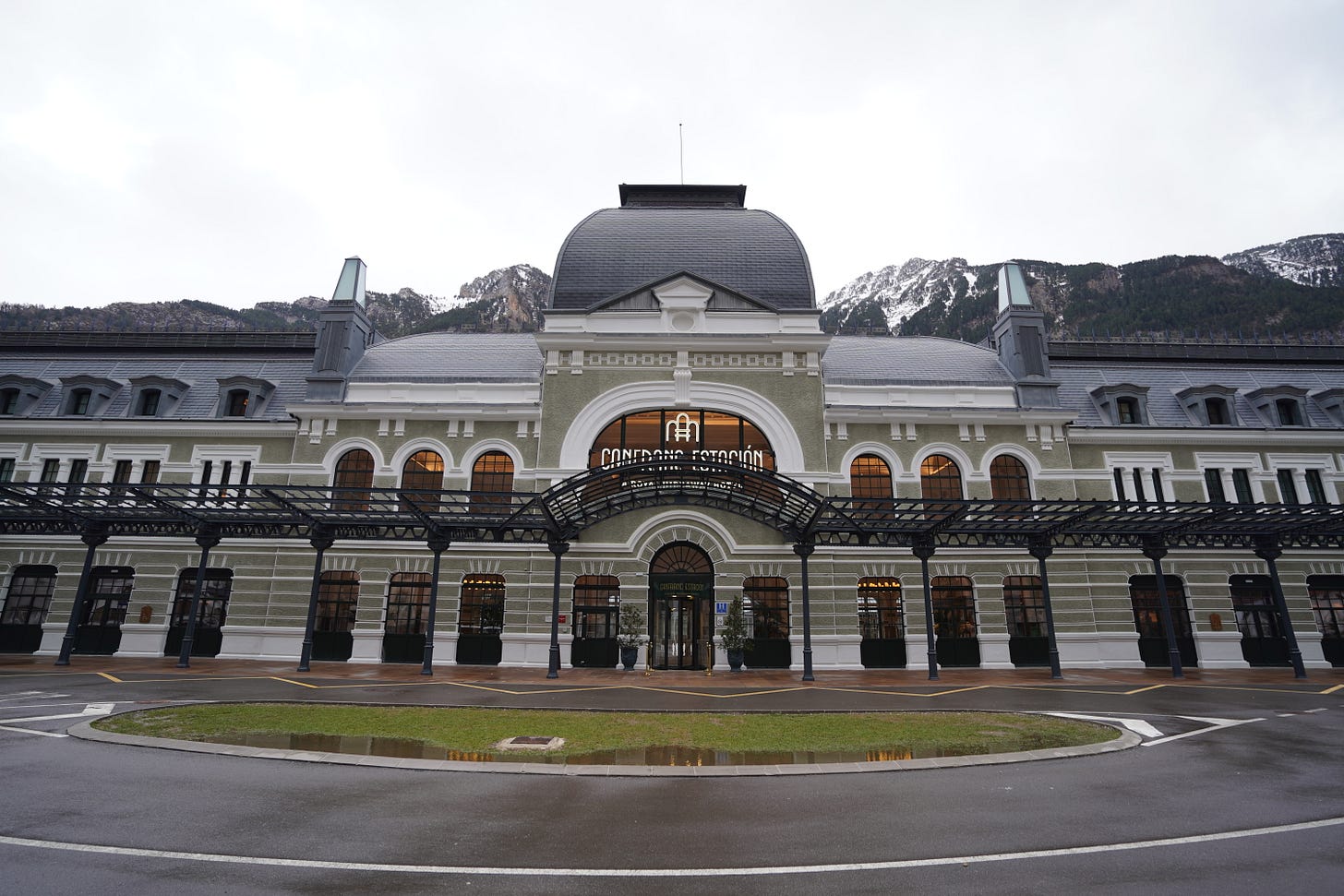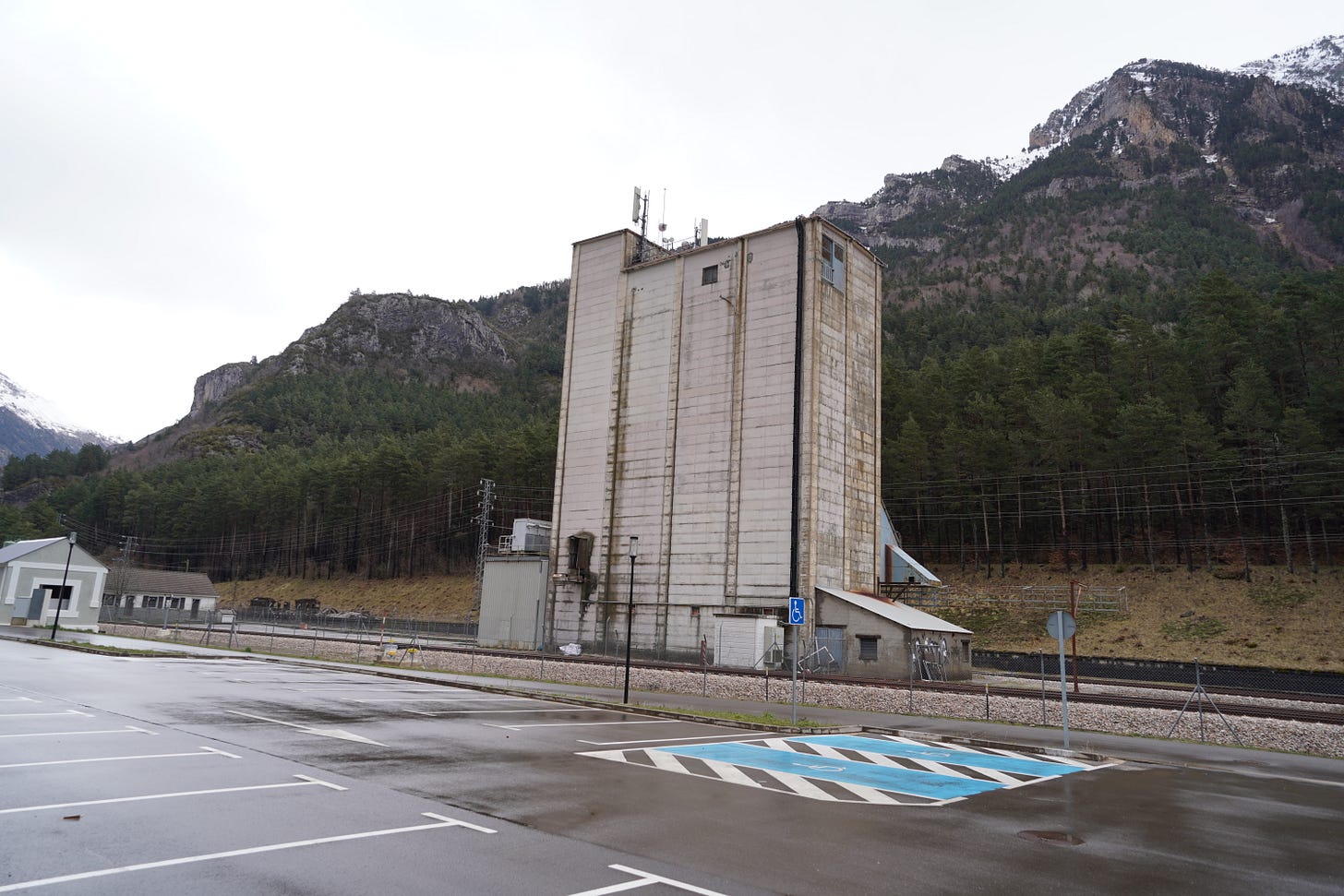Canfranc Hotel: The 'Titanic' of the Pyrenees
Discover the curious story of Canfranc, home to the unluckiest train station in the world.
In the upper reaches of the central Pyrenees, right on the border between Spain and France, stands a railway station like no other.
Grand, yet steeped in mystery, Canfranc International Railway Station has been dubbed the ‘Unluckiest train station in the world’, or others have called it, ‘the Titanic of the Pyrenees’.
Built to connect France and Spain across the Pyrenean mountain border, Canfranc's vast scale and luxurious architecture made it one of the most ambitious and expensive infrastructure projects of early 20th-century Europe.
Although intended as a symbol of international cooperation across the Franco-Spanish border, a series of disasters, world politics, wars and bad luck ensured that Canfranc International Station fell into ruins. For decades, it lay empty, a story not of triumph, but a tale of unfulfilled ambition, wartime secrecy, Cold War shadows, and its eventual rebirth as a luxury hotel.
I visited Canfranc to explore the Titanic of the Pyrenees. Keep reading, or watch my YouTube video to find out more:
Canfranc International Station: A Monument to Ambition
Canfranc Station opened in 1928 as the second-largest railway station in Europe. It was conceived as a joint project between France and Spain to create a seamless cross-border rail connection through the Pyrenees, linking Zaragoza to Pau.
The station was designed in grand Beaux-Arts style, with over 200 metres of platform, hundreds of windows, and dedicated customs and immigration facilities for both countries under a single roof.
But from the start, the station was burdened by its remoteness and the logistical challenges of maintaining a mountain railway. A devastating fire in 1931 damaged much of the interior, and while service continued, it never met the lofty expectations of its builders as passenger numbers dwindled.
A symbol of cross-border cooperation on the border, unusually, half of Canfranc was under sovereign French jurisdiction, while the remainder was Spanish.

The Shadows of War
During World War II, Canfranc gained a more clandestine reputation. When Nazi Germany occupied France, the French half of the station became a base for Wehrmacht and SS units—effectively placing German troops on Spanish soil, albeit technically still within French jurisdiction.
Yet the station also became a lifeline for those fleeing persecution. Allied airmen, political refugees, Jewish families, and spies passed through Canfranc en route to safety in neutral Spain. The station earned comparisons to Casablanca, as a hub of secret wartime activity high up in the Pyrenees.
Meanwhile, Nazi agents used the station to smuggle stolen art, looted gold, and other valuables out of occupied France. Franco's Spain, officially neutral but sympathetic to the Axis, became a discreet transit point. From Canfranc, valuables often moved on to South America, particularly towards the end of the war, and there's no doubt high profile Nazis escaped through the station when the Nazi regime collapsed.
Collapse and Abandonment
After the Second World War, rail traffic resumed, but the station never reached the high level of passenger numbers the investors had envisaged. The final blow came in 1970, when a French freight train crashed and destroyed a bridge just across the border. French authorities decided not to rebuild it, citing cost and low demand. The international rail connection was severed.
For the next fifty years, Canfranc was a ghost station. While limited domestic service continued on the Spanish side to Huesca and Zaragoza, the grand concourse and platforms were left to decay. Moss crept over cracked marble. Ironwork rusted. Trees took root in abandoned warehouses.

Reinvention as a Hotel
In 2023, after decades of dormancy, Canfranc Station reopened—not as a transport hub, but as a luxury hotel. Lavishly renovated, it now offers suites, a spa, and a Michelin-rated restaurant housed in a converted 1920s railway carriage.
The hotel preserves the station’s historical grandeur while reimagining it for a new generation of visitors. Still, the station is not just a boutique, luxury hotel, but it remains a potent symbol of the Golden Age of European rail travel, a time, sadly, long since passed.
A Gateway Reopened?
However, the dream of restoring rail service between Spain and France is not dead. EU funding has been secured to refurbish the line, and modern platforms now stand beside the hotel.
The Canfranc-Pau line, once declared defunct, may soon see trains crossing the border once more. For now, passengers must still rely on a rail-replacement bus to reach Canfranc from Huesca, while Huesca can still be reached by rail from Zaragoza.
The old Somport Tunnel, which links the Spanish and French sides through the mountains, remains intact, if closed. Guard posts, rails, and customs huts still dot the path. The infrastructure is still largely there, and it's hoped that the rail connection will once again connect Spain and France through the Pyrenees.
How to Visit Canfranc International Station
You can reach Canfranc from Zaragoza by train and rail replacement bus, via Huesca (the rail line was closed between Huesca and Canfranc when I visited in March 2025, but should be reopening completely this summer, or so I was told!).
The town itself is small but scenic, with mountain views, hiking trails, and alpine scenery. The station-hotel is open to non-residents who can visit the public areas and learn more about its history, but I'd recommend splashing out for at least one night in the lavish luxury project.
For those interested in rail history, wartime espionage, or borderlands geopolitics, Canfranc offers a rare experience. Guided tours are available, bookable through Canfranc Hotel (they cost approximately 40 Euros).
Where am I now?
After exploring Kurdistan's mountains, I've flown halfway around the world and now find myself on a little island nation in the Indian Ocean.
I'm in Sri Lanka, on a press trip with the British Guild of Travel Writers, the foremost professional body for travel media in the UK. I'll primarily be filming YouTube videos up in the country's north, where the aftermath of the Sri Lanka Civil War (1983- 2009) is keenly felt, but where tourism can also help the once conflict-affected region rebuild.
Join the Borderlines Community
Join me on my quest to explore the world through its borders and boundaries.
Be part of a community of travel enthusiasts who love exploring the world’s cartographic curiosities and geopolitical oddities.
Read more on Travel Tramp.
Follow my new YouTube Channel here: https://www.youtube.com/@traveltramp_uk
This newsletter is a work in progress, so please let me know what you enjoy reading or what you’d like to see in the comments section!






